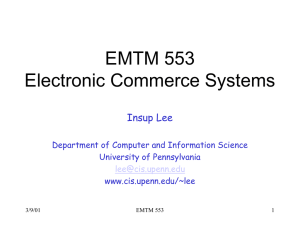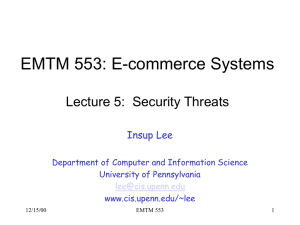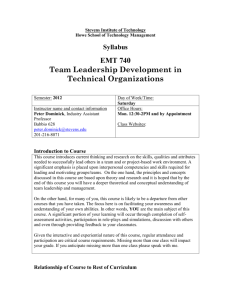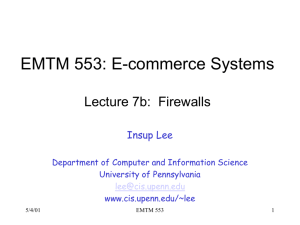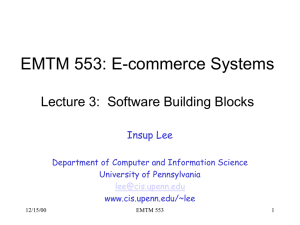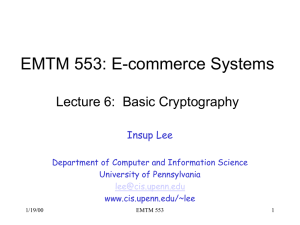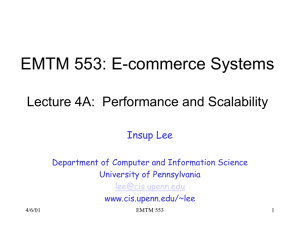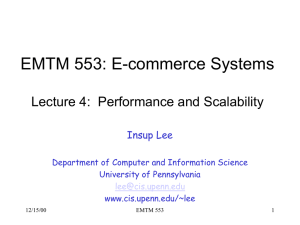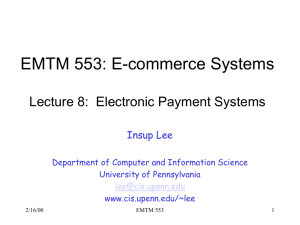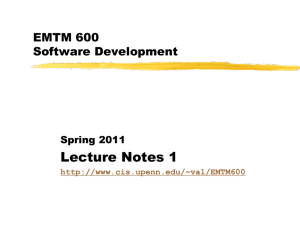E-commerce systems - the Department of Computer and Information
advertisement
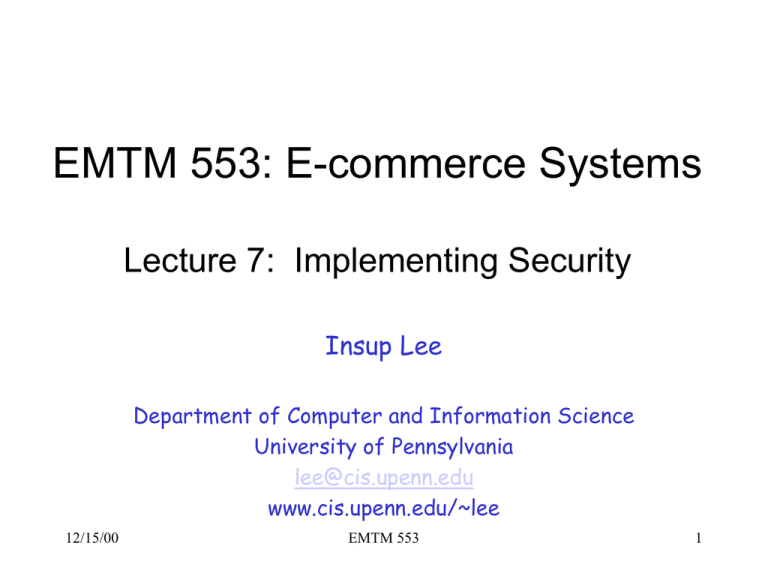
EMTM 553: E-commerce Systems Lecture 7: Implementing Security Insup Lee Department of Computer and Information Science University of Pennsylvania lee@cis.upenn.edu www.cis.upenn.edu/~lee 12/15/00 EMTM 553 1 Objectives • Security measures that can reduce or eliminate intellectual property theft • Securing client computers from attack by viruses and by ill-intentioned programs and scripts downloaded in Web pages • Authenticate users to servers and authenticate servers 12/15/00 EMTM 553 2 Objectives • Available protection mechanisms to secure information sent between a client and a server • Message integrity security, preventing another program from altering information as it travels across the Internet • Safeguards that are available so commerce servers can authenticate users • Protecting intranets with firewalls and corporate servers against being attacked through the Internet • The role Secure Socket Layer, Secure HTTP and secure electronic transaction protocols play in protecting ecommerce 12/15/00 EMTM 553 3 Protecting Electronic Commerce Assets • You cannot hope to produce secure commerce systems unless there is a written security policy – – – – 12/15/00 What assets are to be protected What is needed to protect those assets Analysis of the likelihood of threats Rules to be enforced to protect those assets EMTM 553 4 Protecting Electronic Commerce Assets • Both defense and commercial security guidelines state that you must protect assets from – Unauthorized disclosure – Modification – Destruction • Typical security policy concerning confidential company information – Do not reveal company confidential information to anyone outside the company 12/15/00 EMTM 553 5 Minimum Requirements for Secure Electronic Commerce Figure 6-1 12/15/00 EMTM 553 6 Protecting Intellectual Property • The dilemma for digital property is how to display and make available intellectual property on the Web while protecting those copyrighted works 12/15/00 EMTM 553 7 Companies Providing Intellectual Property Protection Software • ARIS Technologies (part of verance.com) – Digital audio watermarking systems o Embedded code in audio file uniquely identifying the intellectual property • Digimarc Corporation – Watermarking for various file formats – Controls software and playback devices 12/15/00 EMTM 553 8 Companies Providing Intellectual Property Protection Software • SoftLock Services – Allows authors and publishers to lock files containing digital information for sale on the Web – Posts files to the Web that must be unlocked with a purchased ‘key’ before viewing • Digitalgoods.com – infrastructure and integrated services necessary to securely market and distribute multimedia digital content to its maximum audience 12/15/00 EMTM 553 9 Protecting Client Computers • Active content, delivered over the Internet in dynamic Web pages, can be one of the most serious threats to client computers • Threats can hide in – Web pages – Downloaded graphics and plug-ins – E-mail attachments 12/15/00 EMTM 553 10 Protecting Client Computers • Cookies – Small pieces of text stored on your computer and contain sensitive information that is not encrypted – Anyone can read and interpret cookie data – Do not harm client machines directly, but potentially could still cause damage • Misplaced trust – Web sites that aren’t really what they seem and trick the user into revealing sensitive data 12/15/00 EMTM 553 11 Monitoring Active Content • Netscape Navigator and Microsoft Internet Explorer browsers are equipped to allow the user to monitor active content before allowing it to download • Digital certificates provide assurance to clients and servers that the participant is authenticated 12/15/00 EMTM 553 12 Digital Certificates • • • • Also known as a digital ID An attachment to an e-mail message Embedded in a Web page Serves as proof that the holder is the person or company identified by the certificate • Encoded so that others cannot read or duplicate it 12/15/00 EMTM 553 13 VeriSign -- A Certification Authority Figure 6-3 12/15/00 EMTM 553 14 VeriSign • Oldest and best-known Certification Authority (CA) • Offers several classes of certificates – Class 1 (lowest level) o Bind e-mail address and associated public keys – Class 4 (highest level) o Apply to servers and their organizations o Offers assurance of an individual’s identity and relationship to a specified organization 12/15/00 EMTM 553 15 Structure of a VeriSign Certificate Figure 6-4 12/15/00 EMTM 553 16 Microsoft Internet Explorer • Provides client-side protection right inside the browser • Reacts to ActiveX and Java-based content • Authenticode verifies the identity of downloaded content • The user decides to ‘trust’ code from individual companies 12/15/00 EMTM 553 17 Security Warning and Certificate Validation Figure 6-5 12/15/00 EMTM 553 18 Internet Explorer Zones and Security Levels Figure 6-6 12/15/00 EMTM 553 19 Internet Explorer Security Zone Default Settings Figure 6-7 12/15/00 EMTM 553 20 Netscape Navigator • User can decide to allow Navigator to download active content • User can view the signature attached to Java and JavaSript • Security is set in the Preferences dialog box • Cookie options are also set in the Preferences dialog box 12/15/00 EMTM 553 21 Setting Netscape Navigator Preferences Figure 6-8 12/15/00 EMTM 553 22 A Typical Netscape Navigator Java Security Alert Figure 6-9 12/15/00 EMTM 553 23 Viewing a Content Provider’s Certificate Figure 6-10 12/15/00 EMTM 553 24 Dealing with Cookies • Can be set to expire within 10, 20, or 30 days • Retrievable only by the site that created them • Collect information so that the user doesn’t have to continually enter usernames and passwords to access Web sites • Earlier browsers simply stored cookies without comment • Today’s browsers allow the user to – Store cookies without permission or warning – Receive a warning that a cookie is about to be stored – Unconditionally disallow cookies altogether 12/15/00 EMTM 553 25 Protecting Electronic Commerce Channels • Protecting assets while they are in transit between client computers and remote servers • Providing channel security includes – – – – 12/15/00 Channel secrecy Guaranteeing message integrity Ensuring channel availability Authentication EMTM 553 26 Providing Transaction Privacy • Encryption – The coding of information by using a mathematically based program and secret key to produce unintelligible characters – Steganography o Makes text invisible to the naked eye – Cryptography o Converts text to strings that appear to have no meaning 12/15/00 EMTM 553 27 Encryption • 40-bit keys are considered minimal,128-bit keys provide much more secure encryption • Encryption can be subdivided into three functions – Hash Coding o Calculates a number from any length string – Asymmetric (Public-key) Encryption o Encodes by using two mathematically related keys – Symmetric (Private-key) Encryption o Encodes by using one key, both sender and receiver must know 12/15/00 EMTM 553 28 Hash Coding, Private-key, and Public-key Encryption Figure 6-11 12/15/00 EMTM 553 29 Significant Encryption Algorithms and Standards Figure 6-12 12/15/00 EMTM 553 30 Secure Sockets Layer (SSL) Protocol • Secures connections between two computers • Provides a security handshake in which the client and server computers exchange the level of security to be used, certificates, among other things • Secures many different types of communications between computers 12/15/00 EMTM 553 31 Secure Sockets Layer (SSL) Protocol • Provides either 40-bit or 128-bit encryption • Session keys are used to create the cipher text from plain text during the session • The longer the key, the more resistant to attack 12/15/00 EMTM 553 32 SSL Handshake The SSL handshake consists of nine steps that authenticate the two parties and create aEMTM shared 12/15/00 553 session key. [Stein] 33 SSL Web Server Information Figure 6-14 12/15/00 EMTM 553 34 Secure HTTP (S-HTTP) Protocol • Developed by CommerceNet Consortium • Extension to HTTP that provides numerous security features – Client and server authentication – Spontaneous encryption – Request/response nonrepudiation • Provides symmetric and public-key encryption, and message digests (summaries of messages as integers) • Whereas SSL is designed to establish a secure connection between two computers, S-HTTP is designed to send individual messages securely. 12/15/00 EMTM 553 35 Ensuring Transaction Integrity Figure 6-15 12/15/00 EMTM 553 36 Guaranteeing Transaction Delivery • Neither encryption nor digital signatures protect packets from theft or slowdown • Transmission Control Protocol (TCP) is responsible for end-to-end control of packets • TCP requests that the client computer resend data when packets appear to be missing 12/15/00 EMTM 553 37 Protecting the Commerce Server • Access control and authentication – Controlling who and what has access to the server – Requests that the client send a certificate as part of authentication – Server checks the timestamp on the certificate to ensure that it hasn’t expired – Can use a callback system in which the client computer address and name are checked against a list 12/15/00 EMTM 553 38 Protecting the Commerce Server • Usernames and passwords are the most common method of providing protection for the server • Usernames are stored in clear text, while passwords are encrypted • The password entered by the user is encrypted and compared to the one on file 12/15/00 EMTM 553 39 Logging On With A Username And Password Figure 6-16 12/15/00 EMTM 553 40 Operating System Controls • Most operating systems employ username and password authentication • A common defense is a firewall – All traffic from inside to outside and outside to inside must pass through it – Only authorized traffic is allowed – The firewall itself must be immune to penetration 12/15/00 EMTM 553 41 Firewalls • Should be stripped of any unnecessary software • Categories of firewalls include – Packet filters o Examine all packets flowing through the firewall – Gateway servers o Filter traffic based on the requested application – Proxy servers o Communicate on behalf of the private network o Serve as a huge cache for Web pages 12/15/00 EMTM 553 42 Traffic Cop Firewalls Internet Site 1 Site 2 OSI Application Presentation Session Transport Network Data Link Physical 12/15/00 EMTM 553 43 Check Point Software’s Firewall-1 Web Page Figure 6-17 12/15/00 EMTM 553 44
